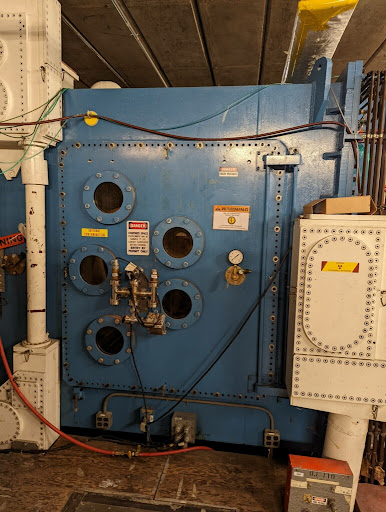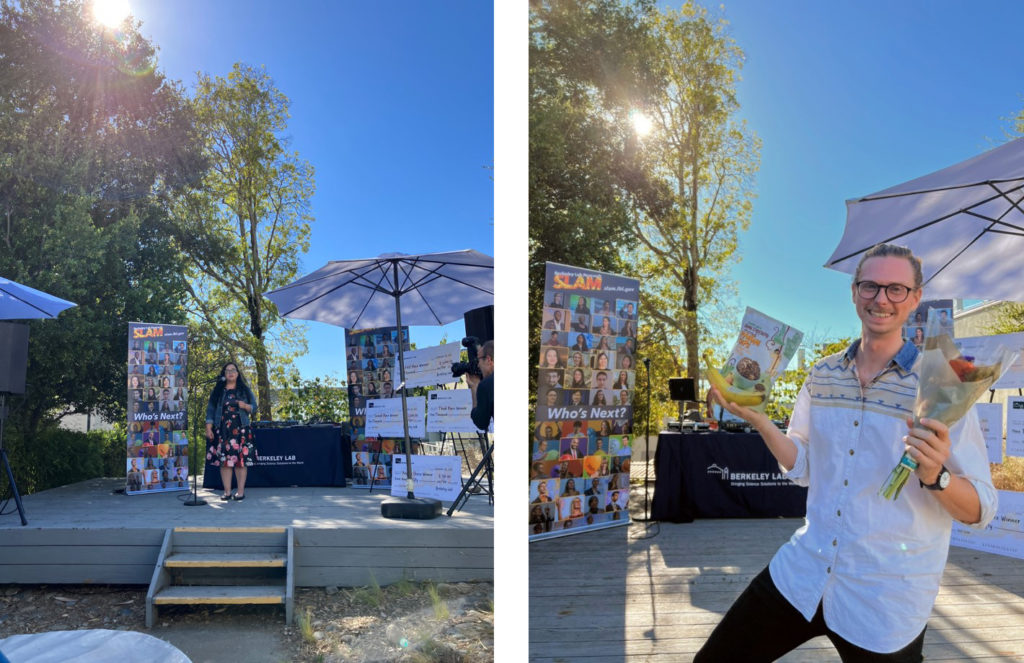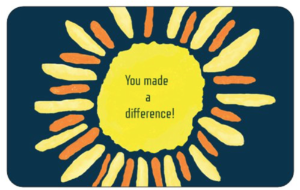In this issue:
- 88-Inch Cyclotron Receives Funding for Upgrades
- LBNL Participates in UF6 Cylinder Measurement Campaign at Fuel Fabrication Facility
- NSD Postdocs Compete in LBNL Research SLAM Final
- Inclusion, Diversity, Equity, and Accountability Moments
- Fragments
-
88-Inch Cyclotron Receives Funding for Upgrades
The 88-Inch Cyclotron facility provides high-intensity, medium-charge-state ions as well as low-intensity, high-charge-state ion beams to its users. The positively charged ion beams are used for experiments ranging from Super Heavy Element searches to radiation effects chip testing at the 88-Inch Cyclotron’s BASE Facility. This flexibility is especially important to the radiation effects testing community who collide ion beams of varied mass and energy into computer parts destined for space, for example, in order to understand how the parts will perform there. Of particular importance to this research are cocktail beams: multi-species ion beams of similar mass-to-charge ratio produced by an Electron Cyclotron Resonance (ECR) ion source that are injected into the cyclotron then accelerated and delivered to researchers one-species-at-a-time via small cyclotron frequency changes performed on minute timescales.

The TRMC funds will provide for upgraded cyclotron vacuum tank doors, shown here, that include additional pumping. The facility recently received funding from the Test Resource and Management Center (TRMC) whose aim is to ensure the Department of Defense Test and Evaluation community has the capabilities to test parts. The 88-Inch Cyclotron is an ideal location for radiation effects testing owing to the high-charge-state ion production capability of its ECR ion sources, the efficient transport of these ions through the cyclotron, the ability of the cyclotron to quickly switch between ions, and the BASE Facility’s precision testing platform. The TRMC-provided funds will be used towards a project aimed at improving the production, transmission, and reliability of the new, higher-energy 20 MeV/nucleon cocktail.
TRMC is interested in the new 20 MeV/nucleon heavy ion cocktail as higher-energy ions penetrate deeper into today’s increasingly complex parts. This cocktail includes the ion 124Xe46+, which is difficult to produce and deliver, due to its high charge state. Vacuum leaks in the cyclotron can affect the amount of beam a user receives.
This project will include additional vacuum pumps for the cyclotron, a new power supply that will improve the stability of the beam on target, and an additional klystron for the VENUS ECR ion source that can aid in the beam production. The funds provided by TRMC will help maintain the 88 Inch Cyclotron as one of the premier locations for space effects testing.
-
LBNL Participates in UF6 Cylinder Measurement Campaign at Fuel Fabrication Facility
Daniel Hellfeld, a Research Scientist in the Applied Nuclear Physics Program, traveled to the Pacific Northwest in April 2022 to participate in a week-long measurement campaign to collect gamma-ray spectra from Type-30B UF6 cylinders used to store and transport uranium of various enrichments for use in nuclear fuel assemblies (see Figure 1). During the week, 12 different cylinders with U-235 enrichments ranging from 0.2% (depleted) to 4.95% (low-enriched) were measured using a room-temperature operated, semiconductor-based, 3D position-sensitive pixelated CdZnTe (CZT) detector system available commercially from H3D Inc.
The collected data (see Figure 2) are being used in the development of new algorithms to improve the spectrometric performance (e.g., energy resolution) of H3D’s pixelated CZT detectors. The International Atomic Energy Agency (IAEA) has expressed interest in these detectors as a replacement for medium-resolution scintillators used for non-destructive assay measurements in nuclear safeguards such as facility inspections and material declaration verification. LBNL is exploring the use of data-driven machine learning approaches (e.g., Non-negative Matrix Factorization) to learn latent spectral features in pixelated CZT detector data in order to optimally cluster and combine list-mode events for overall improved energy resolution.
Figure 1: LBNL Scientist Daniel Hellfeld and H3D detector (mounted on tripod) in front of the Type-30B UF6 cylinder storage yard. Figure 2: Example gamma-ray spectrum measured from a 4.4% enriched UF6 cylinder. The prominent features include the photopeaks at 186 keV (from the U-235 decay chain) and 1001 keV (from the U-238 decay chain). -
NSD Postdocs Compete in LBNL Research SLAM Final
Two Postdoctoral Researchers from NSD competed in the final of the Berkeley Lab Research SLAM. Fatima Garcia from the Low Energy Nuclear Physics Program and Emil Rofors from The Applied Nuclear Physics Program represented the Division in the SLAM competition where contestants are challenged to present a three-minute presentation of their research to a non-specialist audience.
Fatima presented a talk entitled “The Great Periodic Table Debate” in which she provided an insight into how the Superheavy Elements Group is exploring new regions of the periodic table. Emil’s presentation was entitled “Hey Drone, Should I Eat that Banana?” and described how he is combining radiation detectors, robotics, and advanced algorithms to develop new capabilities for the detection and mapping of nuclear radiation.
Twelve presenters competed in the final, delivering their presentations to an audience from across the Lab, and a panel of judges. First place went to Sarah Gleeson, ESA. Second place went to Mohammed Ombadi, EESA. Third place went to Aparajitha Srinivasan, BSA. They will now advance to the regional Bay Area Research SLAM to compete against the finalists from Lawrence Livermore National Lab, Sandia National Labs, and SLAC National Lab.

-
Inclusion, Diversity, Equity, and Accountability Moments

DOE SC RENEW Program and NSD Initiatives
The Reaching a New Energy Sciences Workforce (RENEW) initiative within the DOE Office of Science is intended to build collaborations and develop pipelines for Office of Science research at historically underrepresented institutions, and in historically underrepresented communities. This initiative had a series of Funding Opportunity Announcements (FOAs) in High Energy Physics (HEP), Advanced Scientific Computing Research (ASCR), Basic Energy Sciences (BES) and multiple other programs which closed this past summer, to develop research and career training programs for students at historically underrepresented institutions.
The RENEW initiative follows on from a DOE Nuclear Physics (NP) FOA in early 2021, “Research Traineeships to Broaden and Diversity Nuclear Physics”, which had the same goals, within the specific portfolio of Nuclear Physics. NSD scientists were involved in two responses to this FOA, which both received funding and began running traineeship programs in 2022.
The underGraduate Research Educational Academic Traineeships in Nuclear Science (GREAT-NS) program is led by NSD staff member Jacklyn Gates, with multiple co-PIs within NSD and CSD, as well as collaborating institutions UC Merced, UC Riverside and San José State University. In cooperation with the Workforce Development and Education (WD&E) office at LBNL, and with the help of a dedicated group of NSD postdocs supporting the program, a total of 10 trainees were matched with mentors beginning in the Spring 2022 semester. This cohort started getting into their research projects, and the basics of nuclear science with a weekly series of both introductory lectures and seminars on the topic. For the summer semester, all 10 trainees joined their mentors in-person at LBNL or San José State for a 9-week hands-on session, which included the activities and enrichment offered through WD&E as well as a number of talks and a nuclear science journal club within the GREAT-NS cohort. The Fall semester, beginning now, sees 9 students continuing in the program, focusing on their research projects, as well as a number of graduate school and career-focused panels and activities intended to help them as they move toward their next steps. Seven trainees will also be attending the APS DNP meeting this October as part of the Conference Experience for Undergraduates (CEU).
A separate traineeship effort, the “California Bridge to the Electron-Ion Collider (EIC): Building a Diverse Workforce for Nuclear Physics at the EIC,” is a partnership between the UC Riverside, UCLA, LBNL, LLNL, and Cal-Bridge, a statewide network of California State University, UC, and community college campuses.. It aims to inspire and engage undergraduate students year-round in research efforts at the respective institutions towards the future EIC, a major new facility for Nuclear Physics planned in the U.S. So far, five students have contributed to computer simulations and detector R&D towards the EIC. They have presented their work at the 2022 EIC User Group Early Career Workshop and Meeting, where trainee Luis Garabito was awarded a prize for the best flash talk at his first scientific venue. Four of the trainees will also be attending the APS DNP meeting this October as part of the Conference Experience for Undergraduates (CEU).
Recruitment for the next cohort of GREAT-NS trainees will begin in the spring, with the program to start with the in-person summer session next year. Any NSD staff interested in getting involved as a mentor, or in any other way, please contact us (GREAT-NS@lbl.gov)!
Recent DEI topics @ NSD Staff Meetings
September 13, 2022 – Announcements
June 21, 2022 – Pride MonthLuminary Cards

We’d like to remind everyone, as we continue to largely work remotely, that the Luminary Card program is virtual! You have the opportunity to recognize your co-workers with a virtual or physical Luminary Card for any action fostering inclusion, diversity, and equity within our LBNL community. Recipients who register their cards may choose to be named in this space in a future NSD newsletter.
-
Fragments
NSD held a Staff Appreciation Lunch on September 13th. The event provided an opportunity for members of the Division to meet in-person for lunch, meet new Division Director Reiner Kruecken, and for the Division leadership to show their appreciation of the staff.
NSD hosted the first post-pandemic in-person KamLAND Collaboration meeting from August 31 to September 2, 2022, at Berkeley Lab.
The Nuclear Structure 2022 Conference was hosted onsite at LBNL from June 13-17, 2022. Over 120 participants came in-person to join the meeting for a five-day program covering recent work in low-energy nuclear structure and reactions. Organized by the NSD Low-Energy program, the conference was a great success, with rave reviews from all participants. A special shout-out goes to Tom Gallant for all of his support in putting together and running a great event!
Newsletter notes
Please send any comments, including future story suggestions to Ren Cooper at rjcooper@lbl.gov .
Previous issues of the newsletter are available in the NSD Newsletter Archives
-
Sign up for our newsletter!